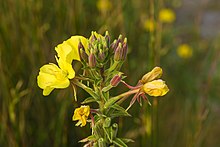Evening primrose oil
| Oenothera biennis | |
|---|---|
 |
|
| Scientific classification | |
| Kingdom: | Plantae |
| (unranked): | Angiosperms |
| (unranked): | Eudicots |
| (unranked): | Rosids |
| Order: | Myrtales |
| Family: | Onagraceae |
| Genus: | Oenothera |
| Species: | O. biennis |
| Binomial name | |
|
Oenothera biennis L. |
|
| Synonyms | |
|
|
Oenothera biennis (common evening-primrose,evening star, sun drop, weedy evening primrose, German rampion, hog weed, King's cure-all, or fever-plant.) is a species of Oenothera native to eastern and central North America, from Newfoundland west to Alberta, southeast to Florida, and southwest to Texas, and widely naturalized elsewhere in temperate and subtropical regions.Evening primrose oil is produced from the plant.
Oenothera biennis has a life span of two years (biennial) growing to 30–150 cm (12–59 in) tall. The leaves are lanceolate, 5–20 cm (2.0–7.9 in) long and 1–2.5 cm (0.39–0.98 in) broad, produced in a tight rosette the first year, and spirally on a stem the second year.
Blooming lasts from late spring to late summer. The flowers are hermaphrodite, produced on a tall spike and only last until the following noon. They open visibly fast every evening producing an interesting spectacle, hence the name "evening primrose."
The blooms are yellow, 2.5–5 cm (0.98–1.97 in) diameter, with four bilobed petals. The flower structure has an invisible to the naked eye bright nectar guide pattern. This pattern is apparent under ultraviolet light and visible to its pollinators, moths, butterflies, and bees.
The fruit is a capsule 2–4 cm (0.79–1.57 in) long and 4–6 mm (0.16–0.24 in) broad, containing numerous 1–2 mm (0.039–0.079 in) long seeds, released when the capsule splits into four sections at maturity.
The seeds of the plant are important food for birds.
The evening primrose was introduced to Europe in the early 17th century as an ornamental plant in botanical gardens. Its possible applications in the kitchen and as medicinal plant were only discovered more than 100 years later. However, indigenous tribes in North America (namely the Cherokee, Iroquois, Ojibwe and Potawatomi) were using the plant as food and medicinal crop for hundreds of years. Today, the evening primrose is mainly known as garden plant and as medicinal plant in specialized sectors. However, almost all parts of the evening primrose are edible and medically or cosmetically applicable. This includes the roots, leaves, blossoms, flower buds and seeds.
...
Wikipedia
